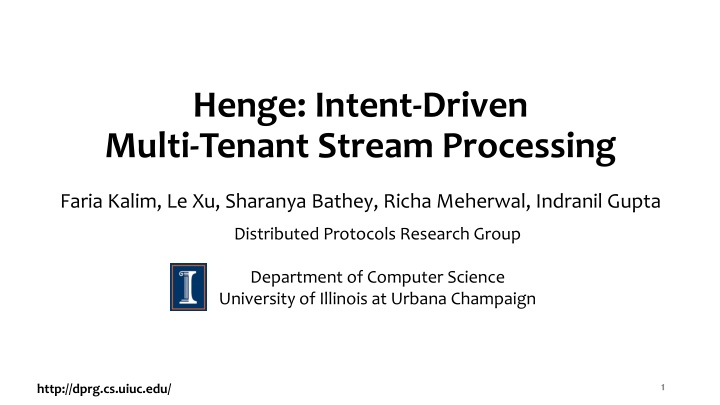
Achieving User-Facing Service Level Objectives in Multi-Tenant Stream Processing
Discover how Henge enables stream processing jobs to satisfy user-specified performance requirements while reducing costs through online resource reconfigurations in a multi-tenant environment. Explore the concept of intent-driven multi-tenancy and its efficient resource usage across multiple users, along with the challenges and solutions related to achieving service level objectives for stream processing jobs on multi-tenant clusters.
Download Presentation

Please find below an Image/Link to download the presentation.
The content on the website is provided AS IS for your information and personal use only. It may not be sold, licensed, or shared on other websites without obtaining consent from the author. If you encounter any issues during the download, it is possible that the publisher has removed the file from their server.
You are allowed to download the files provided on this website for personal or commercial use, subject to the condition that they are used lawfully. All files are the property of their respective owners.
The content on the website is provided AS IS for your information and personal use only. It may not be sold, licensed, or shared on other websites without obtaining consent from the author.
E N D
Presentation Transcript
Henge: Intent-Driven Multi-Tenant Stream Processing Faria Kalim, Le Xu, Sharanya Bathey, Richa Meherwal, Indranil Gupta Distributed Protocols Research Group Department of Computer Science University of Illinois at Urbana Champaign 1 http://dprg.cs.uiuc.edu/
Hengeallows stream processing jobs to satisfy user-specified performance requirements while reducing costs by performing online resource reconfigurations in a multi-tenant environment. 2
A Typical Deployment Job 1 Job 2 Job 3 Job 4 Per-job clusters overprovisioning 3
A Typical Deployment Low level metrics e.g., queue sizes, CPU load as performance indicators Job 1 Job 2 Job 3 Job 4 Manual scaling 4
Intent-Driven Multi-Tenancy Efficient resource usage across multiple users Multi-tenancy 5
Intent-Driven Multi-Tenancy CPU Load, Queue Sizes Efficient resource usage across multiple users Multi-tenancy Application-aware adaptation to user requirements Intent-driven Multi-tenancy Job Description Service Level Objective (SLO) Latency < 5 s 1 Finding ride price 2 Analyzing earnings over time Throughput > 10K/hr. 6
Problem How can we achieveuser-facingservice level objectives for stream processing jobs on multi-tenant clusters? Latency, Throughput 7
Absolute Throughput SLOs are not Useful Rate (Tuples/s) SLO? Day 1 Day 2 Day 2 Day 1 Input Workload Variability Output 8
Absolute Throughput SLOs are not Useful Job Operations Filter Juice: fraction* of the input data processed by the job per unit time. 9
Jobs benefit even below SLO threshold Job Utility Functions Expected Utility Latency SLO Threshold Henge s goal Maximize the total utility of the cluster Current Utility Utility function for a single job 10
Background: Stream Processing Topologies (Jobs) Spou t Splitte r Operators Coun t Logical DAG for a Word Count Job 11
Bolt Sink Spout Spout Sink Bolt Spout Bolt Sink Spout Sink Bolt Star Diamond Topology Topology 12
Background: Stream Processing Jobs [ So ] [ it ] [ goes ] [ So it goes ] [ So ] Coun t Coun t Coun t Coun t [ it ] Spou t [ goes ] Splitter Spou t Splitte r Parallelism 2 Executors (Threads) 13
Background: A Physical Deployment Spout Splitter Count Count Workers 14
Henges Cluster-Wide State Machine Reversion or Reconfiguration Reconfiguration Not Converged Converged Reduction Total System Utility < Total Expected Utility 15
Reconfiguration De-congest operator by increasing parallelism level of executors 3) Black-list topologies that show less than % improvement 1) Reconfiguration 2) Reconfiguration Not Converged Converged 16
Bottlenecks Spout Splitter Count Count Workers 17
Reconfiguration Bottlenecks Spout Splitter Reconfigs. Splitter Splitter Count Count Workers 18
Bottlenecks SLO-Satisfying Job Spout Splitter Reconfigs. Splitter Splitter High Load Count Count Workers 19
Reduction Bottlenecks Reconfigs. High Load Reduction 20
Reduction Reconfigurations drop in utility If high CPU load on majority of machines, reduce parallelism for operators that a) are in topologies that satisfy their SLO b) are not congested Reduction Not Converged 21
Reversion Reconfigurations drop in utility and reduction is not possible Revert to a past configuration that provided best utility Reversion Not Converged Converged 22
Evaluation Real-world workloads: Yahoo! Twitter Web log traces Experimental Setup: 10-40 node Emulab cluster 23
Reducing cost and achieving high utilities 93.5% utility at 40% resources 100% utility at 60% resources 24
Adapting to a Diurnal Pattern Fewer reconfigurations are required once a job has adjusted to max load Day 1 Day 2 Max. Utility Reconfigurations Day 1 Day 2 25
Can Henge do better than manual configuration? Henge does better in the 15th to 45th percentile, and is comparable later. 26
Scaling Cluster Size Limited resources entail more reconfigurations to reach max. utility 27
More Results Henge can: handle dynamic workloads abrupt e.g., spikes & natural fluctuations gradual e.g., diurnal patterns satisfy hybrid SLOs scale with number of jobs & cluster size gracefully handle failures 28
Summary Henge allows users to specify performance intents for their jobs Henge s goal is to maximize cluster-wide utility The scheduler performs fine-grained reconfigurations to allow stream processing jobs to meet user-specified intents 29
